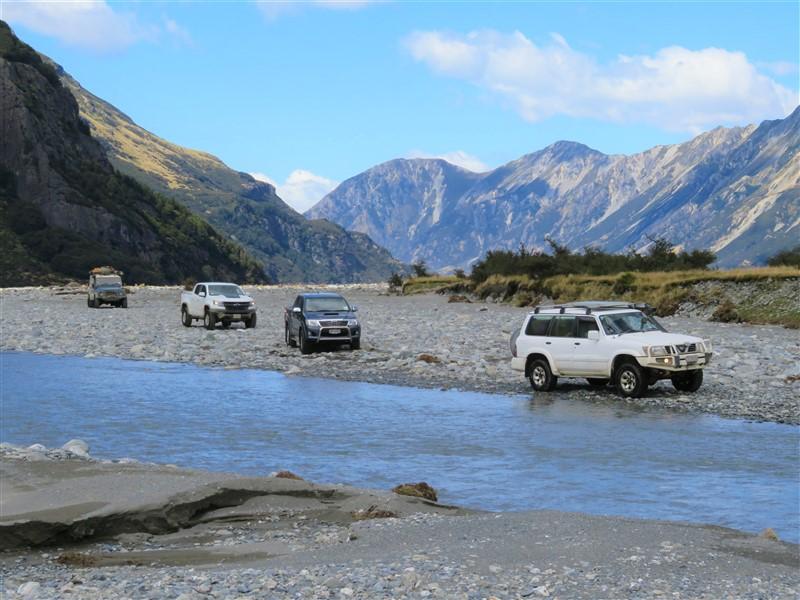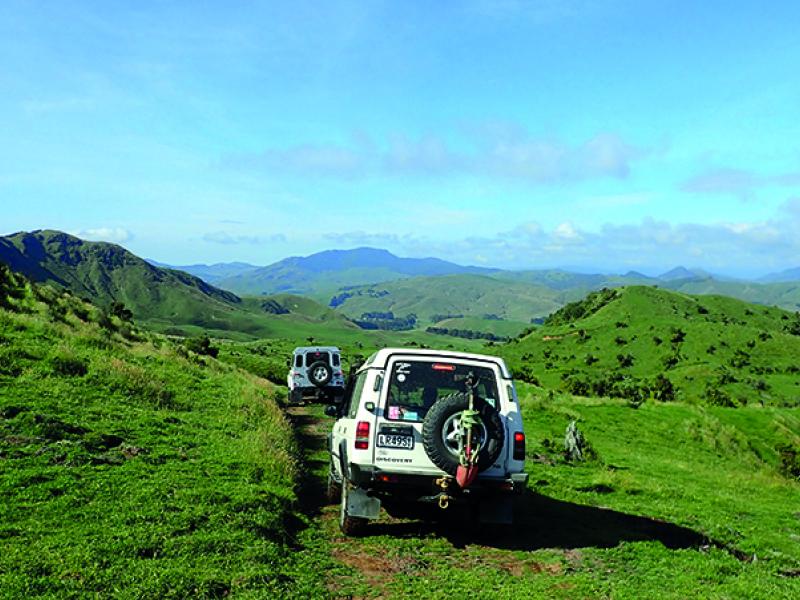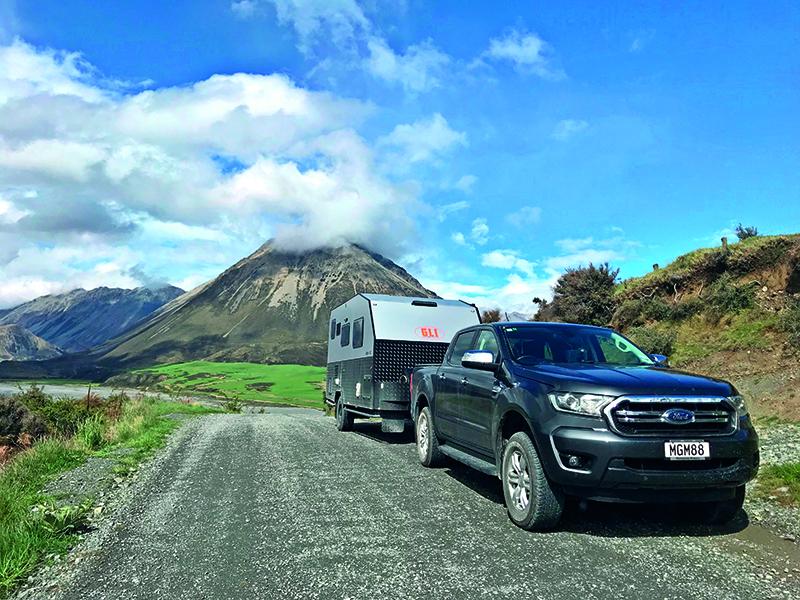Before heading to Siberia last year to drive the BAM Railway support road (see story NZ4WD Nov 2020) Bay of Plenty retirees Martin and Jeanette Knudsen ‘limbered up’ with a ‘Summer Escape’ trip through the South Island High Country.
Early in the year, we attacked our line-up of 4WD events with enthusiasm. Little did we realise that it would be our total travel for Covid-dominated 2020.
First there was the enjoyable Manawatu 4WD Charity Safari from Ngamatapouri, inland from Whanganui, during a weekend in early February. March was taken up with travelling the BAM railway in Siberia, Russia – see my article in November’s NZ4WD magazine. In between we tackled the South Island high country with Stew, Graeme and Linda, on their Summer Escape venture.
The trio are intrepid 4WD adventurers who have been running trips for a number of years. And a listing on NZ4WD magazine’s Events page produced a company of 12 vehicles and 22 participants, 15 guys and seven women.
Martin and I, North Island residents, had tackled South Island 4WDing three times previously, twice freewheeling and choosing our own tracks, and once undertaking an organised gourmet version, staying in comfortable B&Bs where the best of food was served, and driving a set programme of trails.
Challenging adventure
There was nothing ‘gourmet’ about the Summer Escape expedition. We camped in tents, we slept on stretchers, we self-catered, cooking on small gas burners, and we ate pre-packaged easy-cook pasta – at least some of us did. But it was a lot of fun, providing some challenging adventure. And we saw parts of the high country that we would not have ventured into without the leadership of Stew and Graeme. Most of the time, February’s weather was excellent, as well. Our 13-day trip began in Timaru and finished in Tekapo, covering landscapes from remote high country mountains to tussock covered hills and boulder-strewn braided rivers. Some of the tracks we had tackled before, like the Thomson Gorge Road across the Dunstan Mountains, between Omakau and Bendigo. However, we hadn’t ventured before on the side trip up Mt Moka, a very steep track, where in places the road surface was just bare rock. But the wonderful views from the top were reward enough for the effort of getting there.
Macetown and Nevis
Another route we had done several times earlier was the Macetown track, much of it along the Arrow River. But with a change in weather, nature can easily present a different face. A week earlier the area experienced heavy rain, and there was much more water flowing in the river. All enjoyed camping the night at the site of the historic Macetown township.
We had also previously driven the Nevis Valley, but this time we travelled from south to north and included the rough steep road through Carricktown and the Young Australian Historic Reserve.
Some years earlier, we felt the Nevis was hardly a 4WD track and could have been navigated by most cars. Not so this time, for wind and water had been at work to carve out a more challenging trail.
This time, too, we shared the track with several hundred BMW bikers, including teams from overseas, participating in the BMW Motorrad rally through New Zealand.
Top Hut and Buster Diggings
There were numerous new highlights for us, like the West Manuherikia Track between Omarama and St Bathans through the Oteake Conservation Park. The climb to the top traversed a steep impressive track with amazing views back to Mt Cook. Once at our destination in the peaceful high valley, the rest of the group opted to erect their tents, but Martin and I chose the DOC facility, aptly named Top Hut.
We all had the valley to ourselves except for two farm workers who arrived on their bikes from St Bathans to enjoy an hour’s evening exercise.
In the eight degree chill of next morning, the welcome sun tipped over the mountain tops and spread into the valley and onto our outward route, as we crossed numerous streams, and observed rock walls and stone chimneys, relics from the gold days. What a privilege to experience the high country in glorious summer weather.
Trips to the two Mavora Lakes and into Lake Manapouri’s South Arm, the latter bordering Fiordland, were enjoyable new territory for us. As was the Mt Buster Road, from Danseys Pass, north of Naseby through private land, into the Oteake Conservation Park and up to SH83 near Otematata.
Interesting features on the way included the Buster Diggings, an extensive area of high-altitude alluvial gold workings, mined from the 1860s to 1900. Beyond our lunch stop at the Tailings Hut, the track became very narrow, with several challenging steep descents to the Otematata River.
Mt Pisa and Problem Vehicles
Another highlight was the ascent up over Mt Pisa. As we travelled north on SH6 with Lake Dunstan on our right and the Pisa Range on our left, the wall of mountains seemed impenetrable. But as we set out from our overnight campsite beside the station woolshed, and climbed into the hills, the track opened up, and we ascended higher and higher, the view of the Cromwell valley behind us absolutely marvellous.
The steep rough gradient was taxing on the vehicles and one couple in their Land Rover turned back, having lost the ability to change into four-wheel-drive.
The rest of us reached the top and the flat ridge, an ideal spot to wander around and to line the vehicles up for a group photograph. I could not also resist taking photos of the interesting low growing alpine vegetation, in particular a white gentian flower.
On the way down to Cardona we passed the Snow Farm where vehicles and tyres are regularly tested. Little activity was in progress, the snow-making machines idle and the buildings deserted.
There was a moment of anxiety when we reached the locked gate and the combination refused to work; however, help was soon forthcoming and we were on our way.
I mentioned a vehicle that could not make it up the Pisa Range. It wasn’t the only mechanical problem the team encountered. The rough uneven tracks were certainly hard on the trucks and though drivers had done their pre-safari checks and maintenance, a number of participants had problems.
Our Nissan developed a problem with the CV joint in one of the front wheels when we were almost into Macetown, resulting in much diagnostic discussion among the males of the group. Martin carefully nursed it back to town the next day, followed by a ‘minder’ vehicle behind us to make sure we did get out.
The result was that Martin and I enjoyed a rest day in Arrowtown while our vehicle was repaired in Queenstown and the rest of the party tackled the Old Man Range. If you must have a rest day, where better to enjoy it than in beautiful Arrowtown?
The isolated Serpentine
The challenging Serpentine track saw another casualty. The Serpentine is a lonely and isolated area of tussock land, which saw gold mining activity in the 1870s. Having been in Central Otago a number of times, I was pleased to finally have the opportunity to visit the area. It’s only open for 4WDing in summer and autumn, and is best tackled in dry weather and in groups of vehicles.
We drove in from Roxburgh and took the gravel road to Lake Onslow, a remote fishermen’s mecca, and then via the 4WD track into the Serpentine Reserve. It became very rough, a deeply rutted and bog-holed track.
One of our company, towing a state-of-the-art Pioneer trailer behind his Land Rover, attempted to navigate one of the yawning ruts, but became wedged in, and no amount of accelerating and reversing would budge it.
Another Land Rover and strop were needed to haul him out, fortunately all in one piece, despite his little adventure. We descended to the lonely Serpentine Union church, the only remaining building from the gold rush era. It is a striking sight, sitting completely alone in the brown tussock landscape of the reserve.
We were among the leading group of vehicles which reached the church first. We inspected the church and its small collection of chattels and signage. We ate our lunch and we waited for the rest of the party to arrive. After a long interval, news filtered through that one of the vehicles had broken down, with its steering gone. Starting it was impossible.
The group decided to leave it there and ferry the occupants out in another vehicle. Next day they retrieved the problem vehicle.
Up riverbeds
The trip finished with two riverbed journeys along the Hopkins Valley and the Macaulay River. Both were challenging, especially the second as the weather closed in with wind and rain. Earlier storms had altered the boulder-strewn beds and the main streams were fast flowing and marginal for crossing. However we made it to Red Hut, in its beautiful mountain setting.
At the sturdy stone Macaulay Hut, a group of us opted to sleep inside, escaping the strong winds of the night.
All in all it was a great two weeks of adventurous 4WDing. To find out more about Summer Escape trips, see www.summerescape.nz






